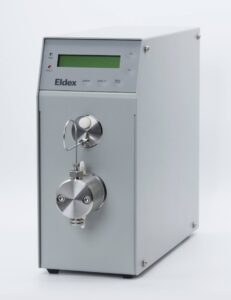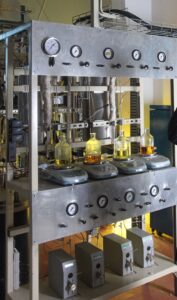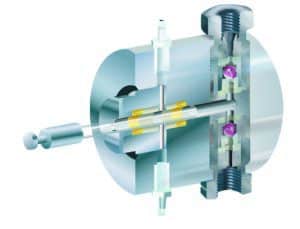Reciprocating Piston Pump Flow Rate Troubleshooting Guide
Troubleshooting flow rates can be accomplished simply if you know what system variable adjustments to make or parts to replace. In this article, we will review some common flow rate issues that can arise, along with suggestions on what to troubleshoot and steps to take once the root cause of the issue has been identified.
TEST PUMP
As a first step, we recommend bench-testing the pump (independent of the system) with isopropyl alcohol (IPA) to eliminate problems caused by cavitation when pumping water (see below). This will enable you to identify the source of the problem more easily. At Eldex, we test all pumps with IPA for this reason.
EXCESSIVE FLOW RATES (GREATER THAN THE SETTING):
Whenever you experience a greater flow rate than the setting, there are three primary causes:
Question | Answer | Solution |
Is the inlet pressure greater than the outlet pressure? | Yes | Pump is siphoning or free flowing. Add some outlet resistance (50 psi or at least 25psi greater than inlet pressure) and retest to see if pump resumes metering fluid |
Is pump’s compressibility setting too high? | Yes | Range from 0-60, Factory set at 4 and retry. Each increment increases motor speed by approximately 1%. |
Is the fluid velocity caused by the output stroke of the pump pulling through more fluid than warranted by the flow setting | Yes | Apply a small amount of back pressure. |
REDUCED FLOW RATES (LOWER THAN THE SETTING):
When we see a greatly reduced flow rate from the actual settings (for example, 20mL/min instead of 40mL/min), several possible causes exist.
Question | Answer | Solution |
Is there some sort of flow restriction in the inlet stream? | Yes | Check for the following to make sure there is no restriction prior to the inlet valve: 1. The viscosity of the liquid 2. Is inlet filter plugged? 3. Is the inlet line pinched? 4. Is the tubing so narrow that is restricting flow |
Is air getting into the system? | Yes | Check for the following: 1. Is there a fitting leak? 2. Is there any cavitation? (If you are pumping water?) To reduce cavitation, you may need to degas prior to using. To degas: 1. Boil. 2. Bubble helium through fluid. 3. Subject fluid to a vacuum. |
Is a vacuum causing cavitation? | Yes | Applying pressure to the inlet reservoir. However, make sure that the inlet pressure does not exceed the outlet resistance. |
Is refill rate set at the factory setting Full Out (10:90 intake:output) | Yes | Change the refill rate to anywhere from 15:85 (still a rapid refill) all the way to 70:30 (slow refill). |
Are there piston seal leaks? | Yes | Replace seal or air will be pulled past the seal and introduced into the fluid stream. |
Is the valve malfunctioning | Yes | Swap valves as required |
ISSUE: NO FLOW
Question | Answer | Solution |
Is the motor turning? | No | Check electrical connections: 1. Is the instrument plugged in? 2. Does outlet provide electricity? 3. Is the fuse blown? If so, replace. |
Is fluid degassed prior to use? | No | Degas fluid prior to use: 1. Boil. 2. Bubble helium through fluid. 3. Subject fluid to a vacuum. |
Is the fluid filtered? | No | 1. Do not pump fluids with suspended particles (a particle as small as ten microns can clog a valve). 2. Install an inlet line filter. 3. Flush with liquid detergent or 20% solution of nitric acid (at max. flow for about 10 minutes), or suck cleaning fluid through pump with a syringe. 4. Ultrasonicate valve assembly. |
Is the filter clogged? | Yes | Clean filter (clogged filter can create restriction to flow, causing cavitation). |
Is the mechanical assembly OK? | No | Inspect parts of mechanical assembly to see if piston is broken or pushrod frozen in bushing. Make the needed repairs. |
Are the valves OK? | No | Rebuild or replace valves – do not exceed 4.5ft/lbs torque on installation. Excessive force used to tighten fittings can cause sapphire seats to crack, chip, or shatter, thereby inhibiting flow. |
ISSUE: ERRATIC FLOW
Question | Answer | Solution |
What is backpressure on the pump? | Less than 25 psi | Insufficient backpressure. Install backpressure regulator or length of small I.D. tubing to create more pressure on the pump so valves can work properly. |
Is fluid degassed prior to use? | No | Degas as per above. |
Is the fluid filtered? | No | Clean valves as per above, install inlet line filter. |
Is the filter clogged? | Yes | Clean filter. |
Is there a leak at fitting(s) | Yes | Tighten fittings. |
Is there a leak at valve connection? | Yes | Tighten valves. |
Are the valves OK? | No | Rebuild or replace valves |
ISSUE: STEADILY DECREASING FLOW RATE
Question | Answer | Solution |
Is fluid degassed prior to use? | No | Degas as per above. |
CONCLUSION
Flow rate issues are to be expected in any pumping system, particularly where precise flow rates are required. We hope this troubleshooting guide has been informative in helping you solve your flow rate issues. We would love to know more about what sort of system you are working on.



